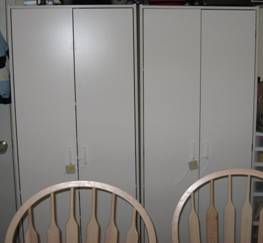
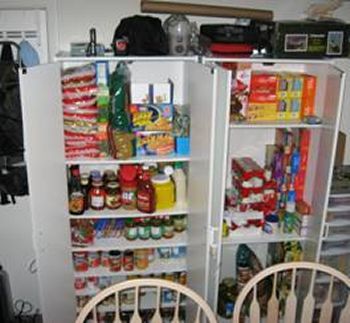
*CREATING STORAGE SPACE IN AN APARTMENT - #3 Design and Upkeep of Storage*
Take a quick look around your apartment. Do you have a lot of bare walls? Where is there empty space? This article in the series deals with designing a storage layout that makes sense for you. After all, if the storage is hard to access and utilize, your system will fail and a sense of frustration will set in. This particular article has pictures of space saving techniques and devices that can be applied in almost any situation.
One of the main reasons that people lack storage in apartments is the lack of cabinetry. But this needn't stop you from being able to create your own! I was able to purchase these two adjustable MDF pantries for a total of $140. This will probably last through 2 or 3 moves with the proper bracing, but these things really aren't made to move around a lot. These are two of the 5 major places I store my preps.


As you can see in the second picture, the shelves are fully adjustable to compensate for different sized packaging. Of course what food stuff you see isn't necessarily what you should have, just what I happen to have at the moment. Storage pantries aren't necessary. You can use boards and crates if you happen to have them. Having a two year old for me though means I have to be able to shut it and lock it. It also looks better having it behind closed doors. Because they are white, they blend into the wall more and don't make an impact on the flow of the room. These particular units are only about 14 inches in depth, so they are not necessarily good for storing all your gear, but they are pretty versatile. Since I have multiple rows of cans for most things, as I use one row, I move to the next row and refill the empty one. A small piece of masking tape with an arrow pointing the right direction helps to make sure you are rotating your food stuff regularly and keeps your place in the pantry. You will also notice that the pantry isn't totally full. The reason is so that I have room to expand as I am able to purchase more quantities of food.
More tricks include utilizing closet space better. This hanging shoe organizer ($10.95 24 pocket canvas organizer at Wal-Mart when I purchased it) is in one of my front closets and holds hats, gloves, baby shoes, and even bungee cords! For the pantry, you can utilize the pockets to store your spice packs (like gravy, sauces, etc.) as well as small bags of beans, rice pouches, pasta packs, etc. Word to the wise. Don't buy the ones at the dollar store. They are plastic, fall apart and don't stay up the way they should.
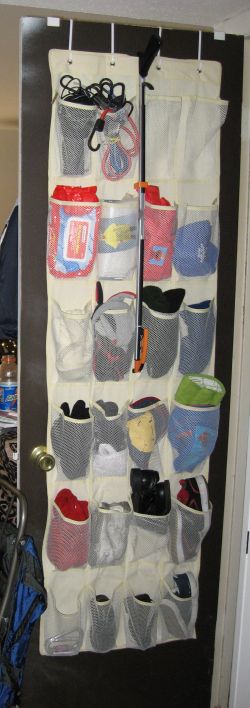
This over the door hook system costs about $10 and holds the family coats, as well as my new backpack! This takes up less space in the closet than having them on hangers so that you can utilize the closet itself for other things.
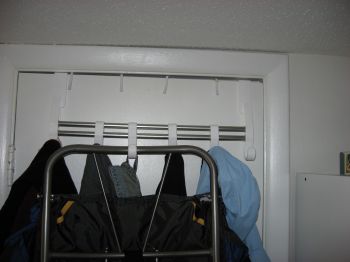
Here is a picture of two of my water storage devices, the blue 7 gallon tank, and what's in the grey bin. The plastic you see through the handles are 10-5 gallon collapsible water storage tanks, along with a couple of oral dispensing syringes (to measure the bleach to purify the water with) a small bottle of bleach solution, and a funnel. This is light and easily portable. My containers hold enough water for my son and me for one month (about 57 gallons total), plus the ability to purify more water and refill the containers. My bottled water is kept in the kitchen.
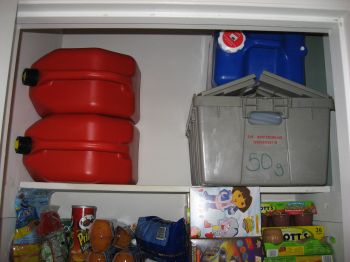
Notice the two gas cans? I am actually in the process of buying three more so that it fills that space. That is 25 gallons of gas that I will be capable of carrying. What you don't see is that there is a twenty dollar bill taped to the bottom of each container (credit goes to pyrotech I think for the article on that) to buy the gas with. I live literally a block and a half from a gas station.
The grey thin box beside the water containers is a camp stove. I have it for camping, actually, but if there was a power outage short term, I could go outside and cook with it. Because of safety concerns, I am storing the fuel canisters in an outside vented storage closet on my porch.
My hygiene and medical supplies are kept in a linen closet. I have a running list of inventory (so I can keep up with what I have and what I need). At the bottom of the closet are cardboard boxes with additional items I don't necessarily use frequently, with a little inventory sheet taped to the top (so I don't have to open ever box to find what I am looking for). You can see I have a bit of catching up with the bag on top of the tp.
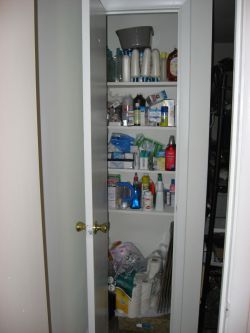
It is these small steps that keep things from being overwhelming. So what about the linens that should go in the closet? I have pull out plastic drawers for sheets sets and my towels go under my sink. No need to waste an entire closet on stuff like that. Other ways to utilize closet space are the 5 or 7 drawer carts for arts and craft supplies (like for my son's room), office supplies, and really just about anything else you can think of. If you see empty space, chances are you can fill it more effectively while not making the room seem crowded.
The most important aspect of creating functional space is the upkeep. If I just threw bags of food into the pantry or left the bags go in my medicine closet, I will absolutely forget what I have. I will not be able to effectively rotate stock. I will waste money and time and energy. Having two hours to evacuate is not a good time to realize you have no idea where your medical supplies are.
One thing that is specific to survivalists that may have to bug out is a way of packing all that food and supplies. Having your bug out bags are the first step, but to go one step further, I suggest empty plastic crates like the one my water storage is in that fit inside each other stored under my workbench. I can sweep a shelf of canned goods into them to keep them contained and get out more quickly than running armfuls at a time and dumping them in the car. If I have to bug out long term, I am going to want to carry as much as safely possible with me.
I hope this gives those in apartments, and even in small houses, ideas and
tips on better storage solutions for your preps.
Belinda
www.alpharubicon.com
All materials at this site not otherwise credited are Copyright © 1996 - 2006 Trip Williams. All rights reserved. May be reproduced for personal use only. Use of any material contained herein is subject to stated terms or written permission.